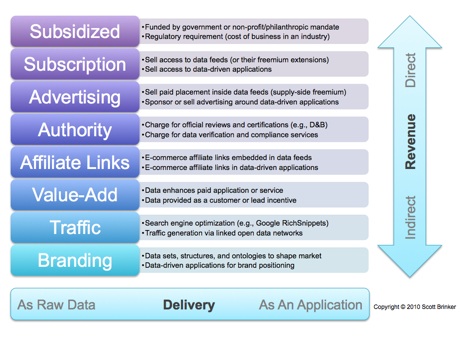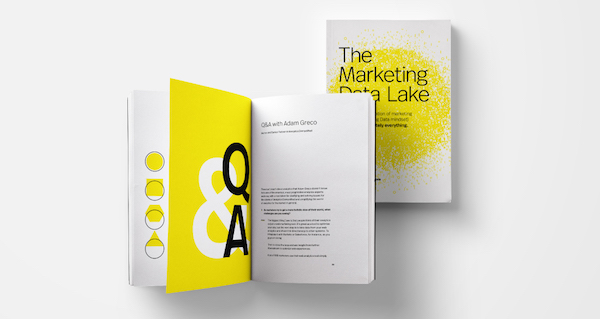In response to my post on linked data business models, Leigh Dodds at Talis wrote a terrific piece with his thoughts on the business of linked data. Leigh presents a number of great ideas that I think really carry the conversation forward.
One of his points is that I overlooked an important model, what he calls the “sponsorship model.” Under this model, a government entity or a non-profit organization has a funded mandate to deliver certain data to the public or their targeted constituency. I’d humbly suggest calling it the subsidized model though, to avoid confusion, because sponsorship is often associated with advertising and branding — very different business models.
Here’s an updated diagram reflecting this additional model:
I put the subsidized model at the top for two reasons. First, it could be argued that it is the most direct revenue source — you’re paid to produce the data before you even put it online. Second, I wanted to put a lot of distance between it and the branded model to emphasize the subtle yet significant distinction between them.
Now, you could debate that this isn’t really a business model per se because it’s clearly non-commercial. However, in the broader sense of the term, it does represent a major “revenue” source that can employ people to produce and maintain such data.
It also happens to be the model behind many of the largest linked data repositories on the web today, such as those from the BBC or the US Census. To ignore it would be to leave unexplained the organizational motivation behind a huge portion of the linked data graph.
I can also see how the subsidized model might apply to commercial organizations, who either have a regulatory requirement for delivering certain information — i.e., a cost of doing business — or a philanthropic arm that engages in good deeds for reasons other than corporate posturing.
But I want to emphasize the subsidized model is not the same as the branded model.
The subsidized model makes the investment in linked data because the delivery of that data is a core part of its organizational mission. It doesn’t need to generate any subsequent financial return from the publication of that data.
The branded model, however, has an ulterior motive for producing linked data: shaping impressions in the minds of the audience who consumes that data — with the intention that such influencing of opinion will lead to future sales and business relationships. It’s the most indirect business model, but indirect shouldn’t be interpreted as inefficacious. The right branding can have tremendous value.
When The New York Times invests in their Linked Open Data initiative, it isn’t altruism. It’s a part of their strategy to retain their brand as the leading authority of news and editorial in the world. It’s a tremendous benefit to the public. But it’s also a powerful move for their business.
I personally think that data branding will become one of the most significant forces behind the widespread adoption of linked data.




Great post. How would you situate GoodRelations in this model? Or as it is still a research project, what business models could it support?
Thanks, Steven.
As an ontology, I imagine that GoodRelations could support any of these models — it would depend on the particular data set that was being modeled with that vocabulary.
That being said, I suspect that the far most common business model for companies implementing GoodRelations would be the traffic model. E-commerce players, such as Amazon and Best Buy online, appear to be using it to gain more visibility in search engines and in other linked data communities. Ultimately, this drives traffic to their online storefronts.
The affiliate model seems like it could also benefit nicely from GoodRelations, if the URLs for actual purchases are generated separately for affiliates who leverage the data in other applications. (Think mash-up development that earns you commissions.)
I still prefer “Data as a Service” over “Raw Data as an Application” 🙂
As per tweet, Applications are one thing (data orchestrators) and Data another. Structured Linked Data as a Service (private or pubic data centers) is a major item re. the Business of Linked Data (BOLD).
As per tweet, Applications are one thing (data orchestrators) and Data another. Structured Linked Data as a Service (private or pubic data centers) is a major item re. the Business of Linked Data (BOLD).